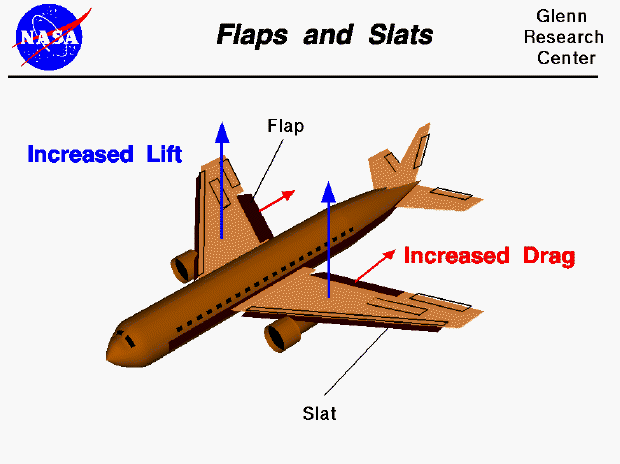

The amount of lift generated by a wing depends on the shape of the airfoil, the wing area, and the aircraft velocity.
During takeoff and landing the airplane's velocity is relatively low. To keep the lift high (to avoid objects on the ground!), airplane designers try to increase the wing area and change the airfoil shape by putting some moving parts on the wings' leading and trailing edges. The part on the leading edge is called a slat, while the part on the trailing edge is called a flap. The flaps and slats move along metal tracks built into the wings. Moving the flaps aft (toward the tail) and the slats forward increases the wing area. Pivoting the leading edge of the slat and the trailing edge of the flap downward increases the effective camber of the airfoil, which increases the lift. In addition, the large aft-projected area of the flap increases the drag of the aircraft. This helps the airplane slow down for landing.
Let's investigate how the flaps and slats work by using a Java simulator.
You can deploy the flaps and slats by using the slider at the bottom.
You can download your own copy of this simulator for use off line. The program is provided as Flaps.zip. You must save this file on your hard drive and "Extract" the necessary files from Flaps.zip. Click on "Flapview.html" to launch your browser and load the program.
The next time you fly in an airliner, watch the wings during takeoff and landing. On takeoff, we want high lift and low drag, so the flaps will be set downward at a moderate setting. During landing we want high lift and high drag, so the flaps and slats will be fully deployed. When the wheels touch down, we want to decrease the lift (to keep the plane on the ground!), so you will often see spoilers deployed on the top of the wing to kill the lift. Spoilers create additional drag to slow down the plane.
Go to...
byTom
Benson
Please send suggestions/corrections to: benson@grc.nasa.gov